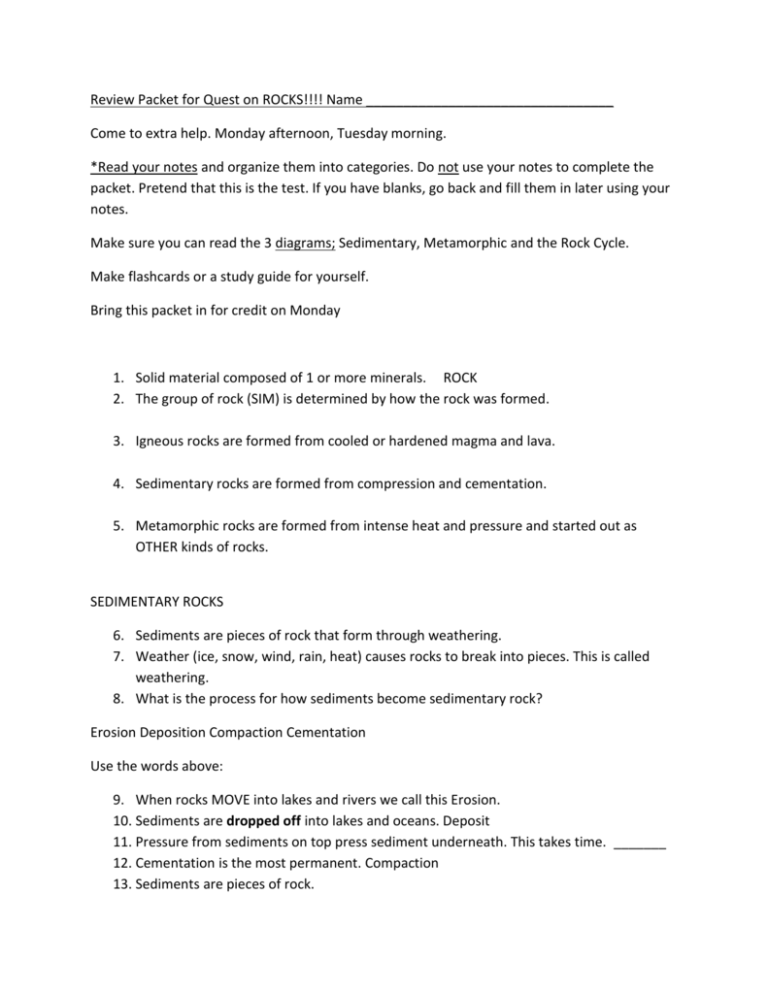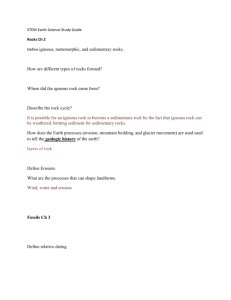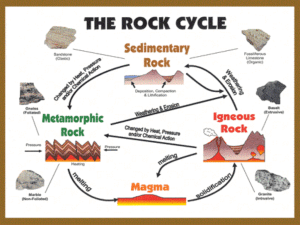Review Packet for Quest on ROCKS!!!! Name Come to extra help
advertisement

Review Packet for Quest on ROCKS!!!! Name _________________________________ Come to extra help. Monday afternoon, Tuesday morning. *Read your notes and organize them into categories. Do not use your notes to complete the packet. Pretend that this is the test. If you have blanks, go back and fill them in later using your notes. Make sure you can read the 3 diagrams; Sedimentary, Metamorphic and the Rock Cycle. Make flashcards or a study guide for yourself. Bring this packet in for credit on Monday 1. Solid material composed of 1 or more minerals. ROCK 2. The group of rock (SIM) is determined by how the rock was formed. 3. Igneous rocks are formed from cooled or hardened magma and lava. 4. Sedimentary rocks are formed from compression and cementation. 5. Metamorphic rocks are formed from intense heat and pressure and started out as OTHER kinds of rocks. SEDIMENTARY ROCKS 6. Sediments are pieces of rock that form through weathering. 7. Weather (ice, snow, wind, rain, heat) causes rocks to break into pieces. This is called weathering. 8. What is the process for how sediments become sedimentary rock? Erosion Deposition Compaction Cementation Use the words above: 9. When rocks MOVE into lakes and rivers we call this Erosion. 10. Sediments are dropped off into lakes and oceans. Deposit 11. Pressure from sediments on top press sediment underneath. This takes time. _______ 12. Cementation is the most permanent. Compaction 13. Sediments are pieces of rock. 14. Clastic or inorganic rocks are made of pieces of other rocks 15. Rocks are named according to the size of the pieces. 16. Give 4 examples of sedimentary rock: Sandstone, Shale, Conglomerate, Limestone 17. Chemical rocks can form by Precipitation or Evaporation. 18. They have a crystalline structure because they are actually minerals. 19. Give an example of a chemical rock: Rock salt. 20. Organic or biological or bioclastic rocks form from living things. 21. Limestone is an example of this because it is formed from crushed sea shells which were once living things. 22. (bituminous) Coal is a rock formed from decaying plant material. 23. Sedimentary rocks can be recognized because they have: Pieces of other rocks Fossils or imprints* Ripple marks (due to water) Layers in the rock.*( Oldest at the bottom, youngest at the top) Look at the sedimentary chart: 24. The grain size goes from: (big to small or small to big.) 25. Composition tells us what the rock is made of. 26. Which rock is inorganic, and has rounded fragments? Conglomerate 27. Which rock has a crystalline structure, fine to coarse grain size and is made of halite? Rock salt IGNEOUS ROCKS 28. Igneous rocks come from the hardening of magma and lava. 29. What is MILE? Magma- intrusive, Lava- extrusive. 30. Intrusive rock is underground, and cools slowly while extrusive rock is on the surface and cools quickly. 31. Which type has bigger crystals? Intrusive Why? It cools slowly and underground. 32. Obsidian is a specific rock which has NO crystals which tells us it cooled VERYquickly. 33. Pumice is a specific rock which has holes or gas pockets. METAMORPHIC ROCKS 34. Metamorphic rocks are rocks that have changed into another rock. 35. Intense heat and pressure create metamorphic rocks. 36. Round pebbles become flat due to a lot of pressure, flat layers become horizontal. Minerals will line up according to their density. 37. Two types of metamorphism are contact and regional. 38. In contact metamorphism, rocks are in contact with the heat from igneous rocks. 39. In regional metamorphism, the plates of the earth collide. 40. Banding or foliation cause stripes in the rocks and the structure will be distorted. 41. A parent rock is the original rock. Use your metamorphic chart: 42. What are the two basic types of metamorphic rocks listed? Foliated, nonfoliated. 43. Slate comes from shale 44. Marble comes from limestone or dolostone. Rock Cycle Diagram 45. How does a sedimentary rock become a metamorphic rock? Weathering, erosion, solidification, melting 46. How does an igneous rock become a sedimentary rock? weathering, erosion. Deposition, compaction, cementation. 47. How do sediments become sedimentary rock? Deposition, compaction, cementation. 48. Why are magma and sediments in a different shape from the other words? They are not rocks. 49. Why is this referred to as a cycle? It continues on and on.









